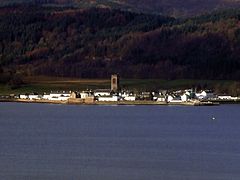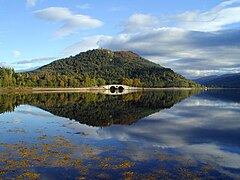inscribed in the margin " Inverary and Loch Fyne" a page from an album inscribed in the frontispage "F W Staines 3 Uplands St Leonards on Sea"
Amelia Jackson, Nee Staines (1842 – 1925) and thence by descent
Inveraray is a town in Argyll and Bute, Scotland. It is on the western shore of Loch Fyne, near its head, and on the A83 road. It is a former royal burgh, the traditional county town of Argyll, and ancestral seat to the Duke of Argyll.
During the Second World War the Combined Operations Training Centre, located close to the town, was an important military facility.
The town's coat of arms depicts a net cast out over the ocean, entangled in which are five herrings and the Latin motto "SEMPER TIBI PENDEAT HALEC" (possible English translation: "may a herring always hang to thee").
Arthur Charles Fox-Davies, in his 1909 book A Complete Guide to Heraldry, notes the following:
There is no doubt of its ancient usage. ...and the blazon of the coat, according to the form it is depicted upon the Corporate seal, would be for the field: "The sea proper, therein a net suspended from the dexter chief and the sinister fess points to the base; and entangled in its meshes five herrings," which is about the most remarkable coat of arms I have ever come across.
Main article: Inveraray Castle

In 1744 the third Duke of Argyll decided to demolish the existing castle and start from scratch with a new building. The castle was 40 years in construction, and the work was largely supervised by the Adam family, still renowned to this day as gifted architects and designers. The end product was not a castle in the traditional sense, but a classic Georgian mansion house on a grand scale, Inveraray Castle.
Over the years the castle has played host to numerous luminaries; Queen Victoria visited it in 1874, and the Royal connection was further cemented when her daughter, Princess Louise, married the heir to the Campbell chieftainship, the Marquess of Lorne, in 1871, illustrating the elevated position of the Argyll family in the social order of the times.

In 1747, William Adam had drawn up plans for the creation of a new Inveraray. By 1770, little had been done, and the fifth Duke set about rebuilding the town in its present form. Some of the work on the rebuilt Inveraray was done by John Adam. The Inveraray Inn (formerly known as the New Inn, Great Inn, Argyll Arms Hotel and Argyll Hotel) on Front Street being his, as well as the Town House. Much of the rest of the town, including the church, was designed and built by the celebrated Edinburgh-born architect Robert Mylne (1733-1811) between 1772 and 1800.
The end product was an attractive town which included houses for estate workers, a woollen mill, and a pier to exploit herring fishing, which was to grow in later years to play a major role in the town's economy. The finished product is one of the best examples of an 18th-century new town in Scotland, and the vast majority of the properties in the centre of Inveraray are considered worthy of protection because of the town's architectural significance.In addition to the castle, the Georgian Inveraray Jail in the burgh is now a museum. Other attractions include the Argyll Folk Museum at Auchindrain. The Celtic Inveraray Cross can also been seen in the town. The Clyde puffers VIC 72, Vital Spark. The Bell Tower dominates the town, and contains the second-heaviest ring of ten bells in the world. The bell tower is open to the public, and the bells are rung regularly.
In autumn 2014, PBS premiered a series, Great Estates of Scotland. Inveraray was featured in one episode, as was the present Duke of Argyll, head of the Campbell clan.
-
Inveraray, viewed from the B839 on the Eastern side of Loch Fyne, above St Catherines
-
Aray Bridge on Loch Fyne from Inveraray. The spires of Inveraray Castle can just be seen on the left. The hill behind the bridge is Dun Corr Bhile
-
Inveraray reflections
-
Main street of Inveraray
-
Archway from Inveraray town
-
Aray Bridge
Loch Fyne , is a sea loch off the Firth of Clyde and forms part of the coast of the Cowal peninsula. Located on the west coast of Argyll and Bute, Scotland. It extends 65 kilometres (40 mi) inland from the Sound of Bute, making it the longest of the sea lochs in Scotland. It is connected to the Sound of Jura by the Crinan Canal. Although there is no evidence that grapes have grown there, the title is probably honorific, indicating that the river, Abhainn Fìne (river Fyne), was a well-respected river.
In the north the terrain is mountainous, with the Arrochar Alps, Beinn Bhuidhe, Glen Shira, Glen Fyne, Glen Croe, Arrochar, Tyndrum and Loch Lomond nearby.
It is overlooked by the Tinkers' Heart, an old travellers' monument. It was a place for weddings to traditionally take place.

The loch has several roads surrounding it. The A83 goes round the head of the loch then travels down the west coast of Loch Fyne, from Ardrishaig to Tarbert along the Knapdale coast. Leaving the A83 north of Cairndow the A815 travels down the east shore of Loch Fyne along the Cowal peninsula coast to Strachur, where to continue down the east shore the A886 leads to Newton. Where you turn off onto the B8000 which carries on down the east shore to Millhouse, where you can go to Portavadie or Kames (direct) or via the Ardlamont peninsula, a longer route to Kames.
At the mouth of Loch Fyne between Portavadie on the Cowal peninsula, on the east shore of the loch. A vehicle ferry traverses the loch to Tarbert on the Kintyre peninsula on the west shore.
Crinan Canal
Main article: Crinan Canal

The Crinan Canal connects Loch Fyne at Ardrishaig and the Sound of Jura at the hamlet of Crinan itself, giving a shortcut for smaller vessels out to the Hebrides saving the longer route of going around the Kintyre peninsula. The canal was built between 1794 and 1801 when the canal was opened, under the supervision of John Rennie. In 1816 Thomas Telford redesigned parts of the canal to remedy technical issues with water supplies for the canal. There are fifteen locks along the canal's 9-mile (14 km) length.
Francis William Staines was the last of a family of merchants from the City of London. Not only was he a successful businessman but he possessed a large independent fortune, such that he could devote his time to the cultivation of his talents in music and art. He was a brilliant amateur violinist, and also loved to spend much of his time painting. His daughter Amelia and her mother accompanied Mr Staines as he travelled throughout the country finding subjects for his painting. One area of the country that they visited frequently was Scotland and the Lake District, and Amelia grew particularly fond of the dramatic landscape of the Fells. Skelwith Bridge with the view of the hills around it 43 was one of her father’s favourite scenes. He painted landscapes and maritime paintings , exhibited 11 works at the RA including views on the Italian Coast, address in London, Hastings and St Leonards on Sea Susssex.







